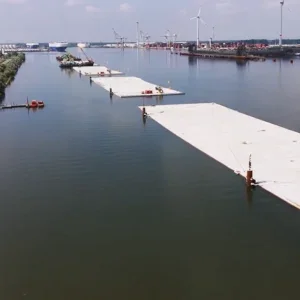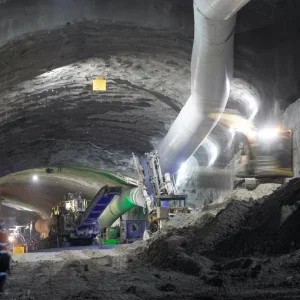The enormous Herrenknecht TBM, designed specifically for the Elbe River tunnel, incorporates several technical innovations, of which the disc changing facility in atmospheric conditions is the most advanced. After gaining access into the pressure protected space of the cutterhead spokes, the discs are replaced as complete pressurised units. First, a gate valve closes off the disc unit from the surrounding ground and water pressure. A small ram is then engaged laterally to hold the unit in place while the bolts are disconnected. As the ram is slowly retracted, the material in the disc housing spills out and a small crane attachment lifts the worn unit out and lowers the replacement one in.
There are 30 double-ring, mono-block disc units on the cutterhead, of which eight are quipped with ‘hammerheads’. These Herrenknecht designed hammerheads do not turn but are made of layers of hard carbide, embedded with hard carbide teeth. These have proved very effective in sticky abrasive material with the occasional boulder. If there are too many boulders, these hammer discs are finished after about 10m, but they last well in sticky abrasive material. After completing 2000m of 14.2m diameter tunnel, 300 discs and 50 hammerheads had been changed. This was much higher than originally expected, but these changes were performed in free air. Only the scraper tools at the edges of the cutterhead slots and the tools on the small centre cutterhead had to be changed under compressed air.
The central 3m diameter cutterhead in the middle of the huge cutting wheel can operate either in tandem or completely independently of the main wheel. It has its own slurry circulation system and has a rotating speed of 2.2 rev/min. The huge 14.2m diameter outer wheel rotates at 1.4 rev/min. The central cutterhead prevents material balling up in the middle of the huge slow turning wheel and so reduces torque and thrust pressure requirements. There are 64 thrust rams on the machine, capable of providing a total thrust of 18 000 tonnes, of which some 14 000 tonnes is used for normal operation.
At the deepest point, the tunnel crown lies 11m below the riverbed, including a 1.5m blanket of copper stone. At the edges of the river, this cover reduces to 9m, including the blanket. With a maximum river depth of 15m at sea level and 17m at high tide, the saturated glacial silts and the water in the charged sand lenses are subject to the full hydrostatic pressure. Together with a margin for safety plus pressure to support the ground itself, the working pressure of the support slurry is up to 5 bar. The TBM is tested to 5.5 bar, and compressed air work for maintenance and repair has been up to 4.5 bar. Control of the support slurry pressures across the 160m² face of the tunnel is completely automatic.
Related Files
Figure 1: the huge Herrenknecht slurry-mode TBM







